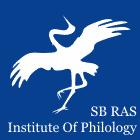 |
|
||||||||||||
|
Institute of Philology of
the Siberian Branch of Russian Academy of Sciences |
|
||||||||||||
|
|||||||||||||
DOI: 10.25205/2410-7883 Roskomnadzor certificate number Эл № ФС 77-84792 | |
| Syuzhetologiya i Syuzhetografiya | |
|
Article
Authors: Lyubov A. Kurysheva Institute of Philology of the Siberian Branch of Russian Academy of Sciences, Novosibirsk, Russian Federation In the section Plot, motif, genre in literature and folklore
Abstract: The Story of Maiden Laciona is a handwritten text, known in a single copy dating back to the 1750s–1760s. This article examines the dating of the tale and the significance of such a narrative element as a vision. The cultural, historical and everyday details of the story allow us to date the its origin to the reign of Elizabeth of Russia (Elizaveta Petrovna). Moreover, the aesthetic markers, such as the description of clothing and jewelry, the design of the ceremonial procession, the mention of the musicians’ specialization, refer specifically to the court life and fashion. The markers observed in The Story of Maiden Laciona are corroborated by a range of documentary sources, including the memoirs of French embassy secretary J.-L. Favier, Chevalier d’Eon, jeweler J. Pauzié, academician and first historiographer of Russian artistic culture J. Stäehlin, as well as the description of the coronation celebrations in Moscow in 1742. The main point of the narrative is the description of the vision that Laciona summons with her art to entertain the guests. It is described how Venus descends from the opened heavens into the room, accompanied by cupids and Mercury, holding a scepter and a ball of golden thread in her hands. She unites the lovers – Laciona and Ludvik, commanding the cupids to shoot at their hearts. Due to the biblical allusions and the high concentration of Church Slavonic vocabulary, the apparition of Venus becomes a highly semiotic episode. The image of Venus with attributes of other female characters – the empress and Ariadne – leads us to the version that the Empress Elizabeth herself is veiled beneath the guise of Venus. As previously shown by researchers, Venus and Ariadne were among the favorite mythological characters who usually represented the empress in court festivities, theatrical productions, and decorative and monumental painting. The ball of golden thread symbolizes the help that the goddess gives to lovers. It has been suggested that in the mid-18th century, the images of a ball of golden thread and a labyrinth were used as a metaphor for help or a way out of a difficult situation. They were replaced by the expressions “Ariadne’s ball” and “Ariadne’s thread” at the end of the 18th century. Keywords: Russian literature of the 18th century, handwritten fiction, The Story of Maiden Laciona, ekphrasis, Elizaveta Petrovna, G. Tiepolo, M. I. Vorontsov, E. R. Dachkova, M. V. Lomonosov Bibliography: Ageeva O. G. Diplomaticheskii tseremonial imperatorskoi Rossii. XVIII vek [Diplomatic ceremonial of Imperial Russia. 18th century]. Moscow, Novyi Khronograf, 2013, 928 p. (in Russ.) Alekseeva N. Yu. Russkaya oda: Razvitie odicheskoi formy v XVII–XVIII vekakh [Russian Ode: Development of the Odic Form in the 17th – 18th Centuries]. St. Petersburg, Nauka, 2005, 369 p. (in Russ.) Belogorskaya R. M., Efimova L. V. Odezhda [Cloth]. In: Ocherki russkoi kul'tury XVIII veka [Essays on Russian culture of the 18th century]. Moscow, 1985, pt. 1, pp. 343–368. (in Russ.) Berkov P. N. O tak nazyvaemykh “petrovskikh povestyakh” [About the so-called “Petrine stories”]. In: Works of the Department of Old Russian Literature. Moscow, Leningrad, 1949, vol. 7, pp. 419–427. (in Russ.) Dedova E. B. Allegoricheskie obrazy v iskusstve feierverkov i illyuminatsii v Rossii serediny XVIII veka: K probleme panegiricheskogo napravleniya v khudozhestvennoi kul'ture Elizavetinskogo vremeni [Allegorical images in the art of fireworks and illuminations in Russia in the mid-18th century: On the problem of the panegyric trend in the artistic culture of the Elizabethan era]. Abstract of Cand. Art Sci. Diss. Moscow, 2011, 30 p. (in Russ.) Epishkin N. I. Istoricheskii slovar' gallitsizmov russkogo yazyka [Historical dictionary of Gallicisms of the Russian language.] Moscow, EST, 2010, 5140 p. (in Russ.) Keldysh Yu. V. Puti razvitiya russkoi muzyki v poslepetrovskuyu poru (30–60-e gg.) [The development of Russian music in the post-Petrine era (1930s–1960s)]. In: Istoriya russkoi muzyki [History of Russian music]. Moscow, 1984, vol. 2, pt. 1, pp. 65–90. (in Russ.) Kurysheva L. A. Gistoriya o devitse Lyatsyone: syuzhetno-motivnyi sostav povesti v kontekste russkoi belletristiki XVII–XVIII vekov [The Story of the Maiden Laciona: Plot and Motif Composition of the Handwritten Tale in the Context of Russian Fiction of the 17th – 18th Centuries]. Syuzhetologiya i Syuzhetografiya [Plot Description and Analysis], 2024, no. 3, pp. 27–45. (in Russ.) DOI 10.25205/2713-3133-2024-3-27-51 Lapteva L. E. Sudebnye preobrazovaniya v Rossiyskoi imperii serediny XVIII v. kak predposylka sozdaniya pravovykh osnov deyatel'nosti gosudarstvennykh uchrezhdenii [Judicial reforms in the Russian Empire in the mid-18th century as a prerequisite for the creation of legal foundations for the activities of state institutions]. RUDN Journal of Law, 2016, no. 3, pp. 57–75. (in Russ.) Muzykal'nyi Peterburg: Entsiklopedicheskii slovar' [Musical Petersburg. Encyclopedic Dictionary]. St. Petersburg, 2004, vol. 1, pt. 7, 320 p. Naymark E. A. Feierverki v ofitsial'nykh torzhestvakh Rossii pervoi poloviny XVIII veka [Fireworks in official celebrations in Russia in the first half of the 18th century]. Abstract of Cand. Hist. Sci. Diss. Moscow, 2010. St. Petersburg, 2010, 26 p. (in Russ.) Slovar' obikhodnogo russkogo yazyka Moskovskoi Rusi XVI–XVII vv. [Dictionary of everyday Russian language of Moscow Rus' in the 16th – 17th centuries]. St. Petersburg, Nauka, 2006, iss. 2, 340 p. (in Russ.) Slovar' russkogo yazyka XVIII v. [Dictionary of the Russian language of the 18th century]. Leningrad, Nauka, 1985, vol. 4, 224 p. (in Russ.) Sokolova Ya. S. Nekotorye zamechaniya o zhivopisnom plafone Bartolomeo Tarsia iz Tantseval'nogo zala Bol'shogo Petergofskogo dvortsa [Some remarks on the painted ceiling painting by Bartolomeo Tarsia from the Ballet Hall of the Great Peterhof Palace]. Vestnik of Saint Petersburg University. Arts, 2022, vol. 12, no. 4, pp. 628–646. (in Russ.) Starikova L. M. Teatral'no-zrelishchnaya zhizn' rossiiskikh stolits v epokhu Anny Ioannovny [Theatrical and entertainment life of Russian capitals in the era of Anna Ioannovna]. Problems of the theatre, 2017, no. 3–4, pp. 117–221. (in Russ.) Zelov D. D. Ofitsial'nye svetskie prazdniki kak yavlenie russkoi kul'tury kontsa XVII – pervoi poloviny XVIII veka (istoriya triumfov i feierverkov ot Petra Velikogo do ego docheri Elizavety) [Official secular holidays as a phenomenon of Russian culture of the late 17th – first half of the 18th century (the history of triumphs and fireworks from Peter the Great to his daughter Elizabeth)]. Moscow, 2002, 304 p. (in Russ.) Zinoveva E. I. Kontsept “vedaniya” v obikhodnom yazyke Moskovskoi Rusi XVI–XVII vv. [The concept of “knowledge” in the colloquial language of Muscovite Rus' in the 16th – 17th centuries]. Vestnik of Saint Petersburg University, 2008, vol. 9, no. 1, pp. 52–53. (in Russ.) |
 |
Institute of Philology Nikolaeva st., 8, Novosibirsk, 630090, Russian Federation +7-383-330-15-18, ifl@philology.nsc.ru |
© Institute of Philology |


